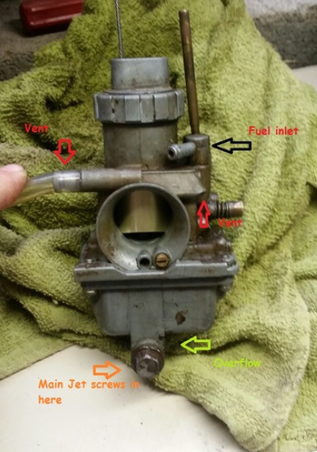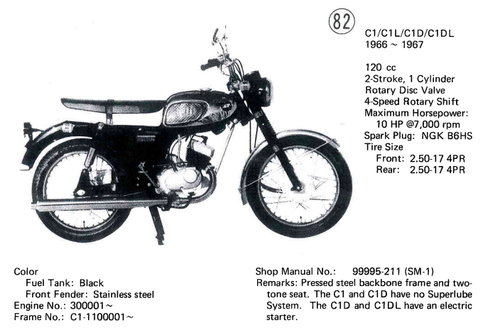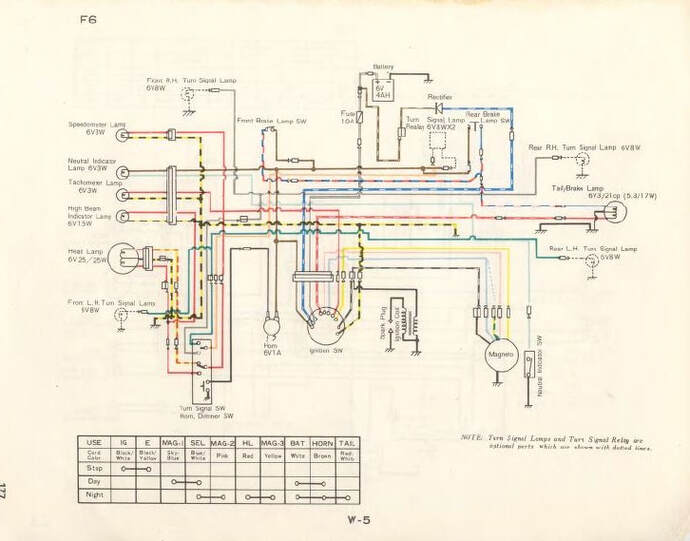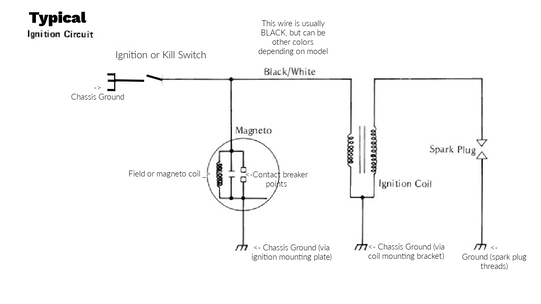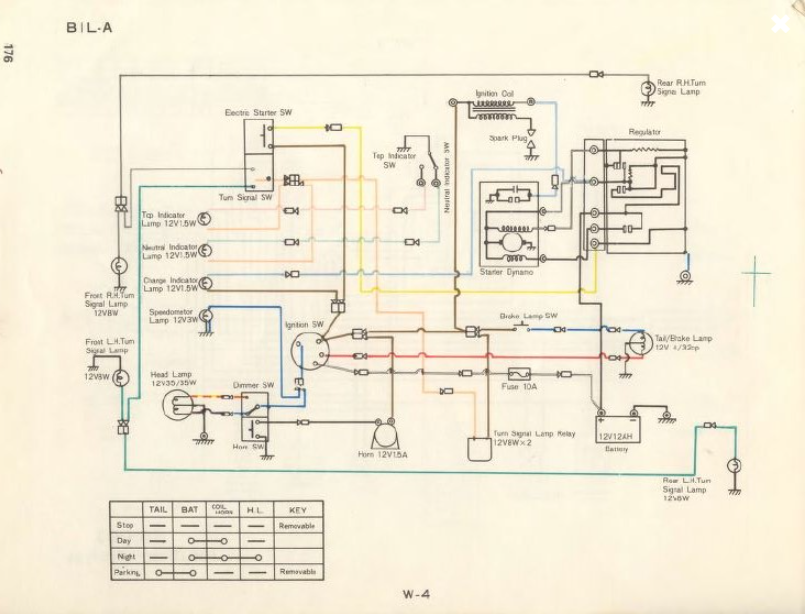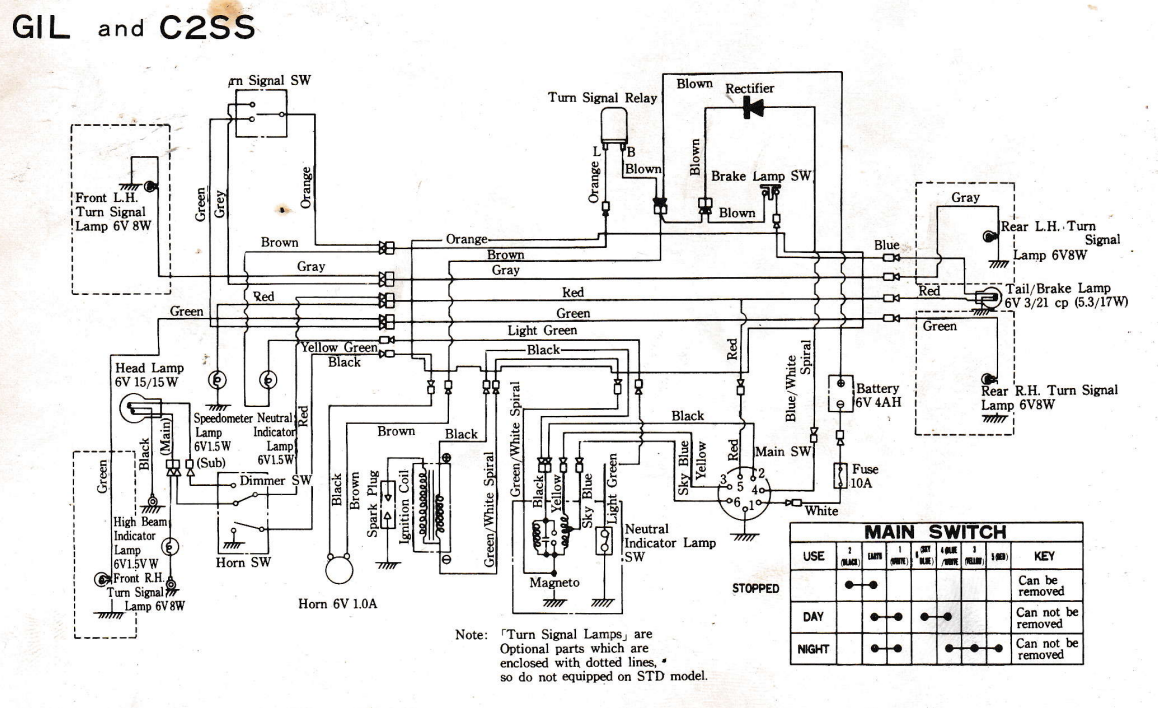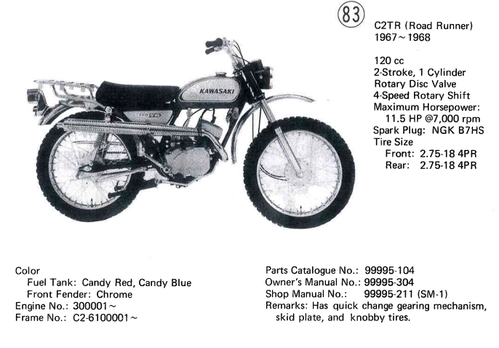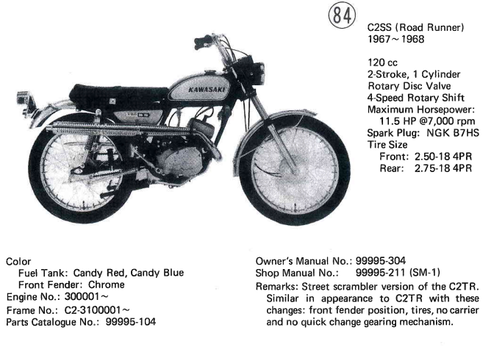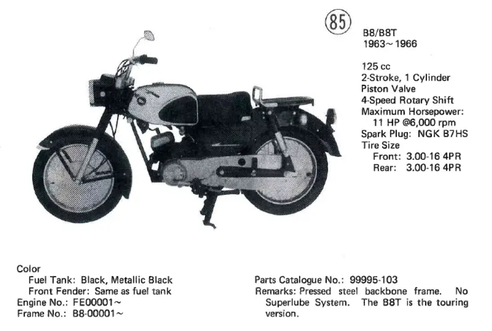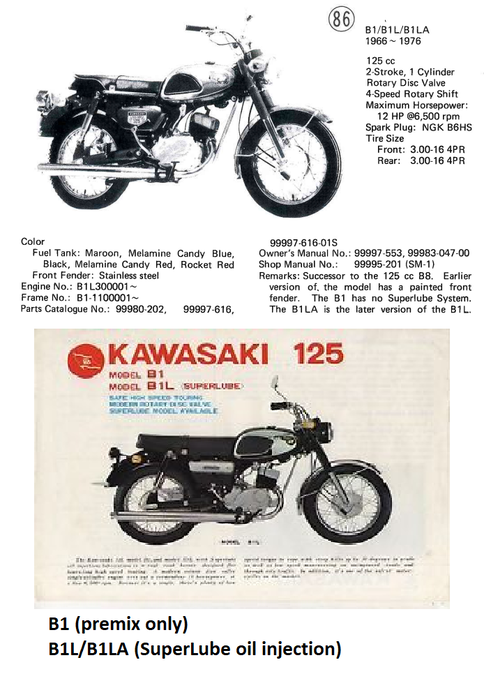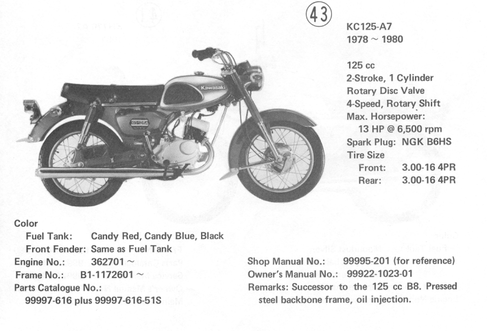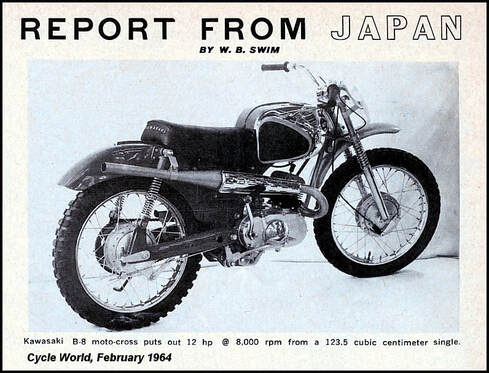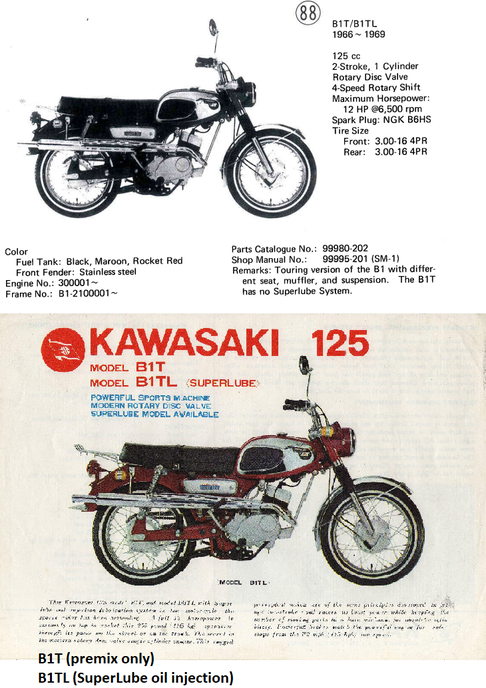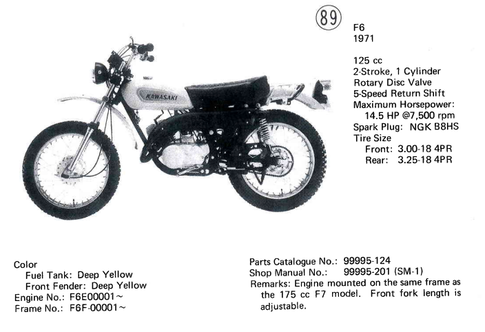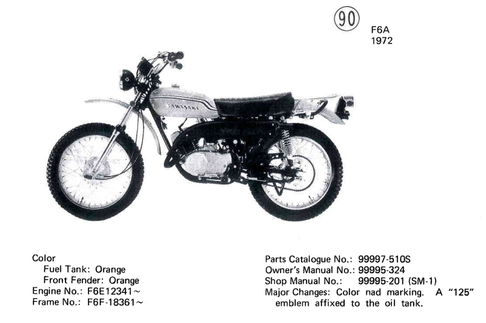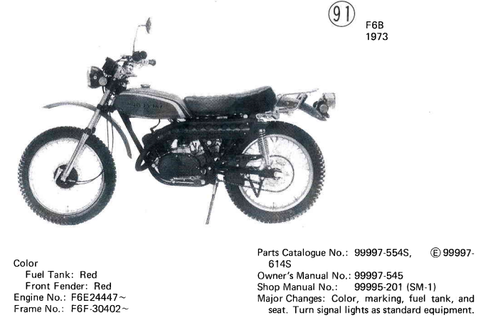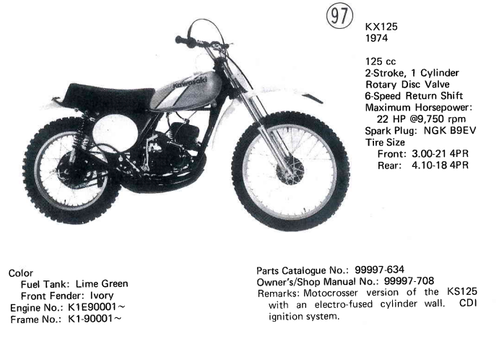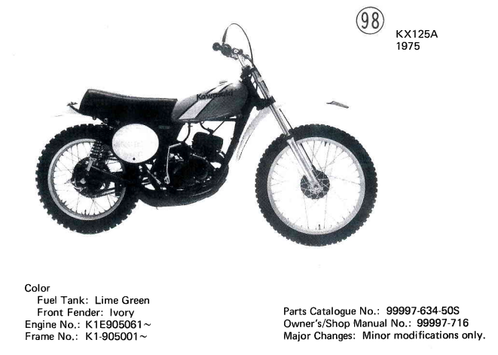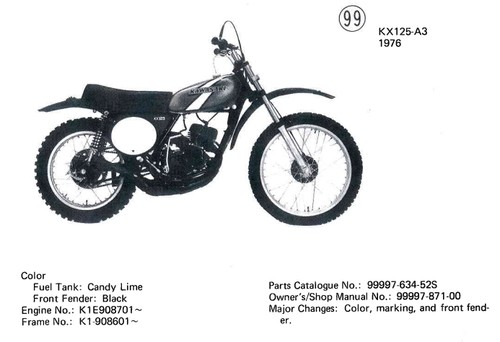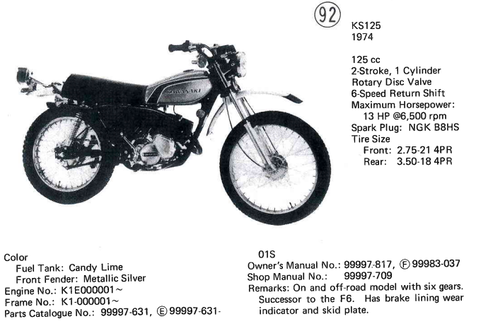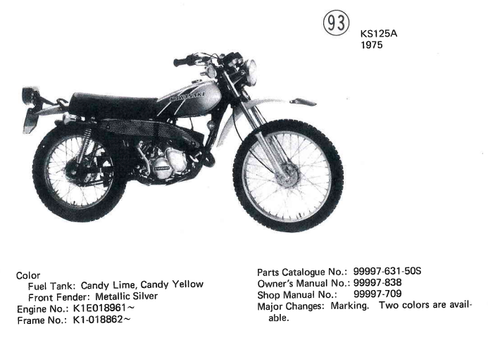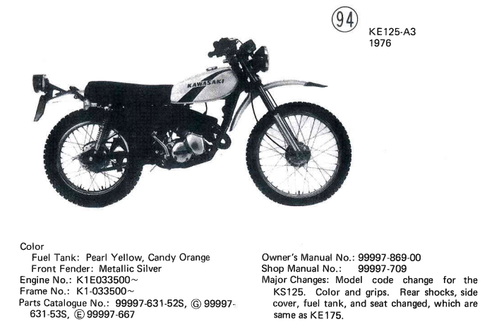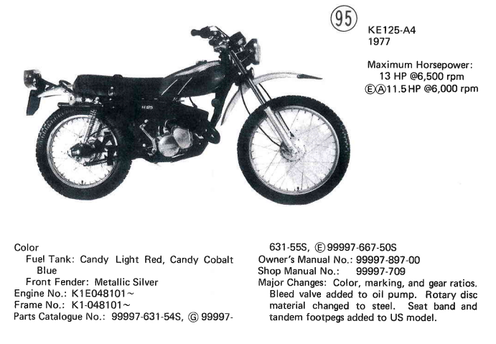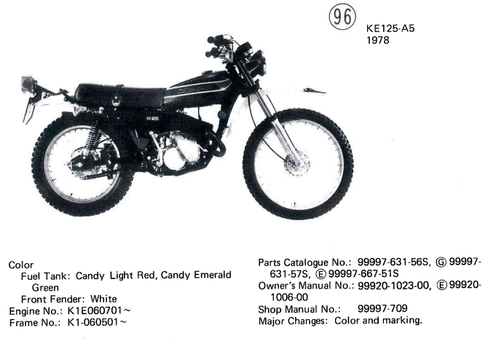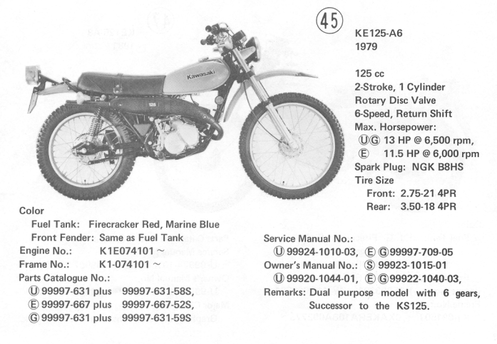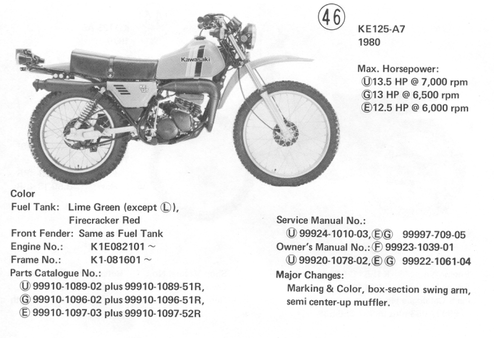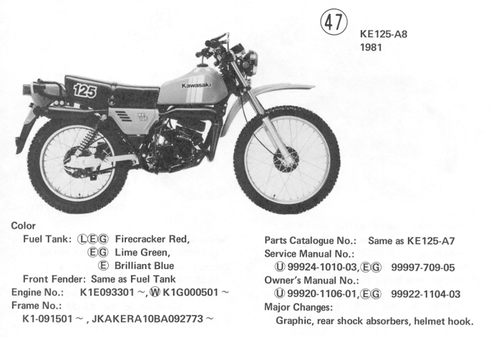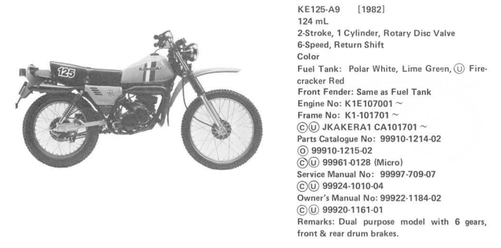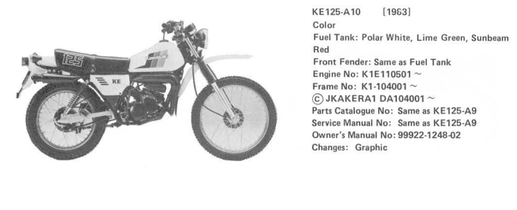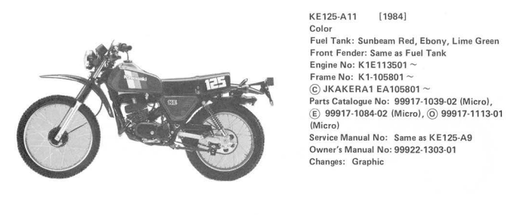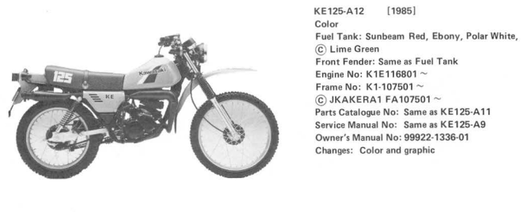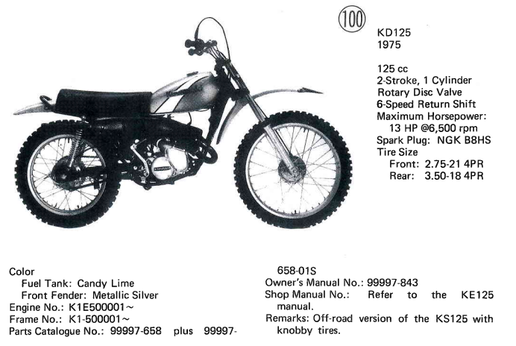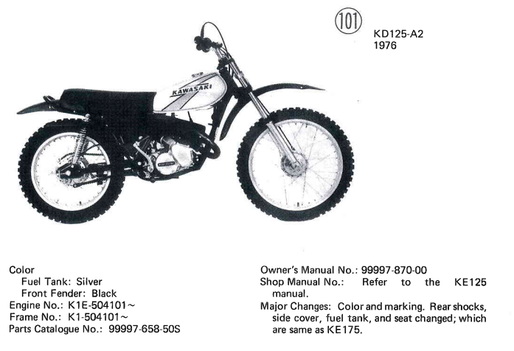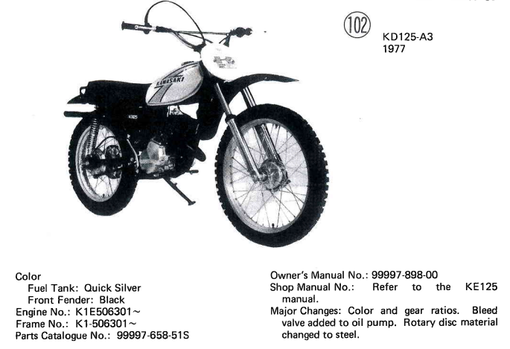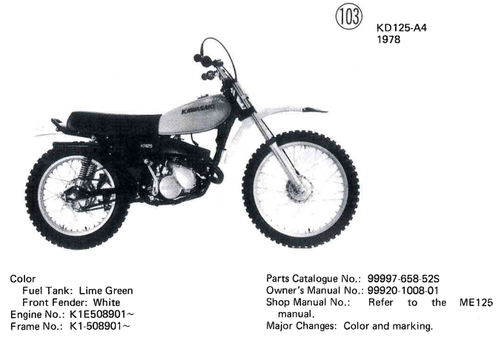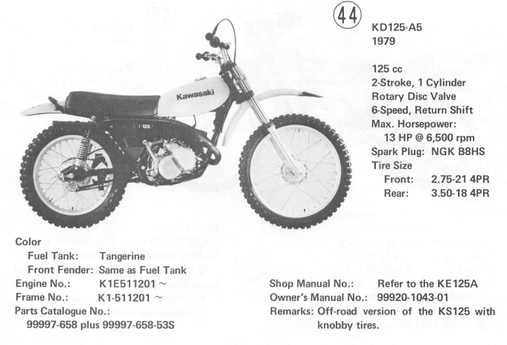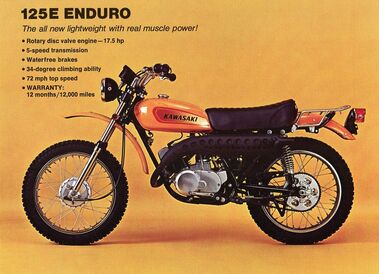 Kawasaki F6
Kawasaki F6
125 CC
B1, B1L, B1LA, F6, KS125, KD125, KE125
120cc C1, C1L, C1D, C1DL, C2TR, C2SS
125cc B8, B8T B8M (piston port)
KX125 rotary valve model (1974-1976)
*Kawasaki did not make the KX125 for 1977. 1978 was the first year for the piston port engine design.
The 125cc category has its heritage with the very early 120cc C-series bikes. Some of the first year 1966 models did not have a separate oiling system and thus required pre-mix. Starting in 1967 models would come equipped with (then new) Kawasaki's Super-Lube. The F6 is the most popular or well known version of the 125cc bikes. The F6 shares very little if almost nothing with the earlier B1 bikes. It shares nearly everything with the, big brother, F7 (175cc) as it is just an F7 lower end with a smaller piston and cylinder. It would appear that the F7 was developed first and then downsized to fit a model into the 125cc category at the time. The B1 series have electric start, a unique feature for a 2 stroke motorcycle. The KS125/KE125 is similar to the F6 but with a different cylinder and piston resulting in lower but broader horsepower. Also appearing for the first time is Kawasaki's first effort at a true purpose built 125cc motocross machine, the KX125, built for the European style motocross tracks. It would feature a rotary valve engine design for its first 3 model years, before taking one year off and becoming a more conventional reed valve piston port design. An interesting product developed only for the rotary valve version of the KX125 was the "Skunk Pipe" aftermarket intake for the KX125 by a company called Skunk Works Engineering. This unique intake might fit the KS/KE125 models as they share similarities to the KX125, but this is yet to be confirmed.
Kawasaki 125cc model identification & specifications information
B1, B1L, B1LA, F6, KS125, KD125, KE125
120cc C1, C1L, C1D, C1DL, C2TR, C2SS
125cc B8, B8T B8M (piston port)
KX125 rotary valve model (1974-1976)
*Kawasaki did not make the KX125 for 1977. 1978 was the first year for the piston port engine design.
The 125cc category has its heritage with the very early 120cc C-series bikes. Some of the first year 1966 models did not have a separate oiling system and thus required pre-mix. Starting in 1967 models would come equipped with (then new) Kawasaki's Super-Lube. The F6 is the most popular or well known version of the 125cc bikes. The F6 shares very little if almost nothing with the earlier B1 bikes. It shares nearly everything with the, big brother, F7 (175cc) as it is just an F7 lower end with a smaller piston and cylinder. It would appear that the F7 was developed first and then downsized to fit a model into the 125cc category at the time. The B1 series have electric start, a unique feature for a 2 stroke motorcycle. The KS125/KE125 is similar to the F6 but with a different cylinder and piston resulting in lower but broader horsepower. Also appearing for the first time is Kawasaki's first effort at a true purpose built 125cc motocross machine, the KX125, built for the European style motocross tracks. It would feature a rotary valve engine design for its first 3 model years, before taking one year off and becoming a more conventional reed valve piston port design. An interesting product developed only for the rotary valve version of the KX125 was the "Skunk Pipe" aftermarket intake for the KX125 by a company called Skunk Works Engineering. This unique intake might fit the KS/KE125 models as they share similarities to the KX125, but this is yet to be confirmed.
Kawasaki 125cc model identification & specifications information
|
F6 Carburetor Settings
Type- VM24SC (24mm) Main Jet - 125 "R" (round head) Needle Jet - 0-2 Jet Needle - 4EJ 13-34Et 3-3 Pilot Jet - 25 Cutaway - 2.5 Air screw - 1-3/4 turns out KD/KS 125 Carburetor Settings Type- VM24SC (24mm) Main Jet - 100 "R" (round head) Needle Jet - 0-4/2 Jet Needle - 4EJ 4-34Et 3-3 Pilot Jet - 25 Cutaway - 2.5 Air screw - 1-3/4 turns out KE 125 Carburetor Settings Type- VM24SC (24mm) Main Jet - 100 (1976-78) 90 (1979-85) "R" (round head) Needle Jet - 0-4/2 Jet Needle - 5EL 17-30-04Et 3-3 Pilot Jet - 20 (1976-78) 17.5 (1979-85) Cutaway - 2.5 Air screw - 1-1/2 turns out B1, B1L, B1LA Carburetor Settings Type- VM22SC (22mm) Main Jet - 190 "(hex) Needle Jet - 0-0 Jet Needle - 4L 6-2Et 3-3 Pilot Jet - 30 Cutaway - 2.0 Air screw - 1-1/2 turns out C1, C1L, C1D, C1DL, C2SS, C2TR Carburetor Settings (120cc) Type- VM18SC (18mm) Main Jet - 140 (C1) 160 (C2SS) Needle Jet - E-0 / E-4 Jet Needle - 4L 4-3 / 4J 9-3Et 3-3 Pilot Jet - 17.5 (both) Cutaway - 1.0 / 2.5 Air screw - 1-1/2 (C1) 2 (C2SS) turns out |
C1, C1L, C1D, C1DL 1966-1967
*120cc models Engine No. 300001- Frame No. C1-1100001- Sort of a middle ground between the D1 (100cc) and 125cc B-series. Same rated horsepower as the D1, but with more torque from the extra 20cc. C1D & C1DL models feature electric & kick start. Oil system: C1/C1D (1966) require premix. 20:1 It had no oil injection system *these bikes probably had a lot of engine failures The C1L, C1DL (1967) incorporated (then new) Kawasaki's Super-Lube |
|
C2TR 1967-1968 Roadrunner
120cc *trail oriented version, selectable dual range transmission Engine No. 300001- Frame No. C2-6100001- First appearance (1968) of the dual range (hi-lo) transmission that would be more recognizable on the G4TR (100cc) effectively giving the transmission 8 speeds. One of the last models to use a rotary shift pattern. Features tubular frame with skid plate and upswept pipe. Upgrades to the internal specifications of the C1L engine to produce 11.5 horsepower over the C1's 10 horsepower. "Enduro" styling with knobby tires and high mount front fender. Oiling system: Kawasaki's Super-Lube |
|
C2SS 1967-1968 Roadrunner
120cc *Street scrambler version, no dual range transmission Engine No. 300001- Frame No. C2-3100001- Very similar to the C2TR, however it does NOT have the dual range transmission or luggage rack. Uses a narrower front tire, different seat, and no skid plate. Oiling system: Kawasaki's Super-Lube B8, B8T 1963-1966
*Piston port models, foundation for the B8M (motocross) Engine No. FE00001- Frame No. B8-00001- Premix only, no oil injection. B8T touring version features 2 up seat and rear luggage rack. Stylistic differences only. Enclosed chain guard. Early 1962 models branded Kawasaki Aircraft. |
|
B1, B1L, B1LA 1966-1976
*Rotary valve version of the B8 piston port (1963-66) Engine No. B1L300001- Frame No. B1-1100001- The first 125cc rotary valve model. Low pipe street model. Also features electric & kick start. *This model possibly ceased importation in the US around 1969 (citation needed), but lived on in other countries until a model number change in 1976 to the KC125 Oil system: B1 (1966) require premix. 20:1 It had no oil injection system *these bikes probably had a lot of engine failures The B1L/B1LA (1966-76) incorporated (then new) Kawasaki's Super-Lube *see brochure & remarks |
|
B8M, 125B1M, B1-M 1963-1966
*rare 125cc motocrosser that was a JDM model only (not a rotary valve) This model is a piston port model based off the B8 street bike. This model never made it to the US market. This and the J1M (85cc) were developed for the Japanese motocross championships. Known as the "Red Tank" models. These were sold in Japan and kickstarted Kawasaki's entry into motocross racing world wide. This bike was the impetus for models like the G31M, F21M, and F81M. "Run by the Motorcycle Federation of Japan (MJF), the first All-Japan Motocross championship was held on May 19 1963 on a course in Aonogahara, Hyogo Prefecture. Kawasaki entered the race with as yet unseasoned riders and commercially available model 125cc B8 bikes tuned up into racers, but the superb durability and running performance of the model on the bad roads and jumps lead to a sweep of the top six positions for Kawasaki in the 125cc class." |
|
B1T, B1TL 1966-1969
*upswept pipe version of the B1/B1L Engine No. 300001 Frame No. B1-2100001- Different shocks and seat to accommodate 2 up riding. Upswept pipe styling. Also features electric & kick start. Mechanically identical to the B1/B1L. Oil system: B1T (1966) require premix. 20:1 It had no oil injection system *these bikes probably had a lot of engine failures The B1TL (1966-69) incorporated (then new) Kawasaki's Super-Lube *see brochure & remarks |
|
F6 1971
*Completely new 125cc model Engine No. F6E00001- Frame No. F6F-00001- The first completely new "Enduro" model for the 125cc class. Shares some cosmetics as well as the frame and most of the lower end engine parts as well as the exhaust from the F7 (175cc), just with a 125cc cylinder and matching head. The F6 does not have the HATTA forks with the adjustable axle position, but they are adjustable up & down for front end height, just like the F7. The F6 uses a conventional contact breaker point ignition, unlike the F7's CDI ignition. The F6 also has a smaller front wheel. |
|
KX125 1974
*rare motocross competition model Engine No. K1E90001- Frame No. K1-90001- The first and only rotary valve model in the entire KX (motocross) lineup. Can sometimes be confused with the KD125 or KS125 as it shares some engine covers. This model is completely unique using its own frame & suspension. Exhaust is a down tube expansion chamber with stinger. Use engine & frame numbers for positive identification of each. Cylinder is electro plated and has CDI ignition. 22 horsepower. An aftermarket company called "SkunkWorks Engineering" created a unique intake pipe specifically for the KX125 they called the "Skunk Pipe" |
|
KX125A 1975
*minor modifications, motocross competition model Engine No. K1E905061- Frame No. K1-905001- Nearly identical to the 1974 model. Use engine & frame numbers to confirm model year. Read more about the "Skunk Pipe" aftermarket intake for the KX125. |
|
KX125 A3 1976
*stylistic changes, black fenders Engine No. K1E908701- Frame No. K1-908601- Third and final year for the rotary valve KX125. Later models would be piston port and then reed valve. Use engine & frame numbers to confirm year. Read more about the "Skunk Pipe" aftermarket intake for the KX125. |
|
KS125 1974
*Complete redesign from the F6 Engine No. K1E000001- Frame No. K1-000001- Redesign & update. The KS125 shares very little with the previous F6. New frame, different suspension, and completely new engine featuring 6 speeds over the previous 5. Rated power is down from 14.5 to 13, but it is rated at a lower RPM, thus power delivery changed to broaden the delivery. Now with larger "big bike" 21 inch front wheel. |
|
KE125 A7 1980
*Major model refresh Engine No. K1E082101- Frame No. K1-081601- Stylistic updates including a larger fuel tank, seat, box type swingarm, new "lay down" shock mounting. Engine is now painted black. New exhaust with expansion chamber and separate muffler that routes higher and is tucked away from the rider. The use of a proper expansion chamber increases horsepower from 13 to 13.5. |
|
KD125 1975
*Off road version of the KS125/KE125 Engine No. K1E500001- Frame No. K1-500001- Only differences from the KS125/KE125 is the absence of lights and wiring for the lights. Mechanical and performance is identical. Can be initially confused visually with the KX125 of this year because of the styling. |

